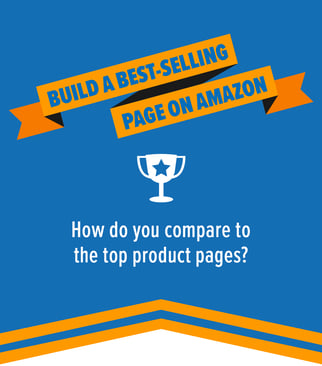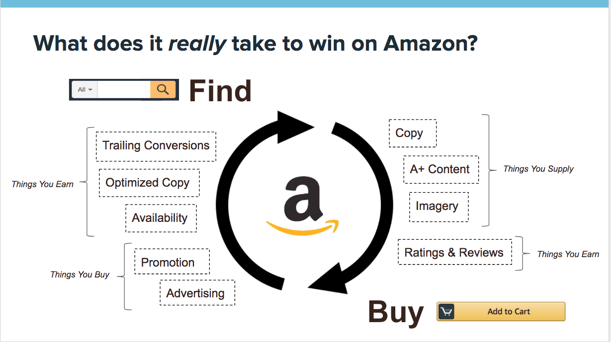Faced with the fierce competition on Amazon, it can be overwhelming to know where to focus and how best to grow sales, build your market share, and protect your brand. Josh Silverman, Director of Analytics and Data Science at Salsify, and I recently spoke to these challenges and shared some strategic insights to help you navigate the ecommerce giant. Listen to the 30-minute webinar or take a look at the highlights we've gathered for you.
What does it take to win on Amazon?
Amazon is a conversion machine: If you can make your products convert at a higher rate than competitors, then they will appear higher in search. Higher search rank will result in more sales which will result in more reviews which will result in higher conversion rate and higher search rank.
But achieving the coveted high search rank and high conversion rate requires you to compete on multiple fronts for every SKU you sell.
You can take a strategic approach by optimizing the factors that you can control, for example the content you supply or ad placements you buy, and how to best impact the factors that you earn, like trailing conversion rate and ratings & reviews.
What product content do you need to rank higher on Amazon?
Product copy is the easiest and fastest way for Amazon’s search engine (A9) to associate your products with a search term. First, identify which terms you should be ranking for. The Amazon search bar is a great place to start. You can also use several tools: Merchant words, JungleScout, UnicornSmasher, KeywordEye and Salsify Insights, which can you help you identify key search terms.
Once you’ve determined the most important high value search terms, consider how best to use them. A majority of Amazon purchases happen on mobile where the title is the primary copy you see without significant scrolling. Use keyword terms in bullets and meta data backend keywords as well. Amazon recommends including a keyword once in your copy – and our research and analysis has consistently found that is the appropriate number of times to include each important term. Keyword stuffing makes it harder for shoppers to understand what you are selling. Shoppers want clear copy that conveys key benefits and answers their primary questions, not a comprehensive list of all features.
What is the right number of images, bullets or reviews to add to my Amazon product page?
We could simply say, make sure you have 5+ high resolution images, 5+ bullets and 30+ reviews, but we recommend a much more strategic approach for two important reasons:
- You aren’t competing against a static product page. You are competing against the other brands in your space and their best product listings. The digital world makes it possible for you to iterate and optimize – and your competitors will be doing the same.
- You can't effectively compete across all your SKUs at once. Our most sophisticated brand manufacturers aren’t concentrating on investing equally across their whole catalog. Instead, they use insights to focus on their most winnable battles.
Given that context, an interesting pattern emerges when it comes to quantity of product content assets. The Salsify team has done a deep statistical analysis of hundreds of thousands of top-ranking products competing for conversion on Amazon.
Here’s what we learned:
- More images on a product page listing can drive conversion. In our analysis we have seen that if you take two listings that appear side-by-side in a SERP, then the one with more images will convert higher and outrank the competitor 53% of the time. This is only a slight edge, but this is just one aspect of the content you supply and these advantages will accumulate.
- The quantity and quality of your bullets have an impact. Our analysis shows that if you take two listings that appear side-by-side in a SERP, then the one with more bullets will convert higher and outrank the competitor 51% of the time. Again, this might seem like a small advantage, but these advantages add up to something big and create a positive feedback loop.
- More reviews improve your performance. When the top products for a search are battling over rank we see clearly that more reviews help with conversion and thus search placement. If you take two listings that appear side-by-side in a SERP, then the one with more reviews will convert higher and outrank the competitor 58% of the time. That is an incredible advantage. Here is more advice on how to improve customer reviews.
Ultimately, Amazon rewards higher conversion with higher search placement. Each of your products needs to outshine its competitors. Regardless of whether you are using AMS & Promotions, in the long-run your products need to convert at a higher rate than the competition when buyers land on the page. You can supply content, earn content and buy your way to better conversion which will create a self-reinforcing feedback loop. We’ll be continuing to share our latest insights in our blog and webinar series.
You can also read our recently released Product Page Benchmark Report, which looks at patterns in what the top performing and lowest performing Grocery pages on Amazon have in common.
Written by: Andrew Waber
Andrew Waber (he/him) is a data-driven ecommerce expert and former director of insights at Salsify, where he led research initiatives to help brands optimize their digital retail strategies.
Recent Posts
Personalization at Scale: How To Use AI To Tailor Product Search for Every Shopper
How To Build an Ecommerce Marketing Calendar
Generative AI in Ecommerce: How AI Is Shaping the Next Generation of Product Search
Subscribe to the Below the Fold Newsletter
Standing out on the digital shelf starts with access to the latest industry content. Subscribe to Below the Fold, our monthly content newsletter, and join other commerce leaders.





.svg)